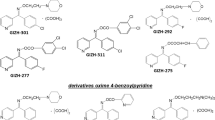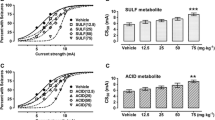Abstract
The role of zinc in seizure models and with antiepileptic drugs sodium valproate (SV) and phenytoin (PHT) was studied using experimental models of seizures in rats. Male Wistar rats, 150–250 g were administered zinc 2, 20, and 200 mg/kg, orally for 14 days. Sixty minutes after the last dose of zinc, rats were challenged with pentylenetetrazole (PTZ, 60 mg/kg, ip) or maximal electroshock (MES, 70 mA, 0.2 s duration). In another group, SV (150/300 mg/kg, ip) or PHT (40 mg/kg, ip) was administered after 30 min of zinc administration followed by seizure challenge. Zinc pretreatment at all doses had no effect on MES seizures. In PTZ seizures, with the lowest dose used, i.e., 2 mg/kg, a protective effect was observed. Neither the protection offered by the 100 % anticonvulsant dose of SV (300 mg/kg) in PTZ seizures was affected by pre-treatment with zinc nor a combination of subanticonvulsant dose of SV (150 mg/kg) and zinc offer any statistically significant advantage over either drug alone. The combination of phenytoin with zinc had no effect on any of the parameters tested. Apart from this, chronic zinc administration hampered development of chemically (PTZ)-kindled seizures in rats. Zinc supplementation is unlikely to have any undesirable effect when used in epileptics rather it may offer advantage in epileptic and seizure prone patients.







Similar content being viewed by others
References
Frederickson CJ, Bush AI (2001) Synaptically released zinc: physiological functions and pathological effects. Biometals 14:353–366. doi:10.1023/A:1012934207456
Takeda A (2000) Movement of zinc and its functional significance in the brain. Brain Res Rev 34:137–148. doi:10.1016/S0165-0173(00)00044-8
Grabrucker AM, Rowan M, Garner C (2011) Brain delivery of zinc ions as potential treatment for neurological diseases: mini review. Drug Deliv Lett 1:13–23. doi:10.2174/2210303111101010013
Ganesh R, Janakiraman L (2008) Serum zinc levels in children with simple febrile seizure. Clin Pediatr (Phila) 47:164–166. doi:10.1177/0009922807306165
Farahani HN, Ashthiani AR, Masihi MS (2013) Study on serum zinc and selenium levels in epileptic patients. Neurosciences (Riyadh) 18:138–142
Saad K, Hammad E, Hassan AF, Badry R (2014) Trace element, oxidant, and antioxidant enzyme values in blood of children with refractory epilepsy. Int J Neurosci 124:181–186. doi:10.3109/00207454.2013.831851
Ristic AJ, Sokic D, Bascarevic V, Spasic S, Vojvodic N, Savic S, Raicevic S, Kovacevic M, Savic D, Spasojevic I (2014) Metals and electrolytes in sclerotic hippocampi in patients with drug-resistant mesial temporal lobe epilepsy. Epilepsia 55:e34–e37. doi:10.1111/epi.12593
Peixoto-Santos JE, Galvis-Alonso OY, Velasco TR, Kandratavicius L, Assirati JA, Carlotti CG, Scandiuzzi RC, Serafini LN, Leite JP (2012) Increased metallothionein I/II expression in patients with temporal lobe epilepsy. PLoS One 7:e44709. doi:10.1371/journal.pone.0044709
Sarangi SC, Tripathi M, Kakkar AK, Gupta YK (2014) Effect of antiepileptic therapy on trace elements status in Indian population in a tertiary care hospital from northern India: a cross sectional study. Epilepsy Res 108:917–927. doi:10.1016/j.eplepsyres.2014.01.014
Baraka AM, Hassab El Nabi W, El Ghotni S (2012) Investigating the role of zinc in a rat model of epilepsy. CNS Neurosci Ther 18:327–333. doi:10.1111/j.1755-5949.2011.00252.x
Doering P, Stoltenberg M, Penkowa M, Rungby J, Larsen A, Danscher G (2010) Chemical blocking of zinc ions in CNS increases neuronal damage following traumatic brain injury (TBI) in mice. PLoS One 5:e10131. doi:10.1371/journal.pone.0010131
Elsas SM, Hazany S, Gregory WL, Mody I (2009) Hippocampal zinc infusion delays the development of after discharges and seizures in a kindling model of epilepsy. Epilepsia 50:870–879. doi:10.1111/j.1528-1167.2008.01913.x
Khanna N, Garg A, Sharma KK, Khosla R (1997) Modulation of convulsive threshold of pentylenetetrazole by zinc. Indian J Clin Biochem 12:86–90
Lee JY, Kim JH, Palmiter RD, Koh JY (2003) Zinc released from metallothionein-iii may contribute to hippocampal CA1 and thalamic neuronal death following acute brain injury. Exp Neurol 184:337–347. doi:10.1016/S0014-4886(03)00382-0
Zhu L, Ji XJ, Wang HD, Pan H, Chen M, Lu TJ (2012) Zinc neurotoxicity to hippocampal neurons in vitro induces ubiquitin conjugation that requires p38 activation. Brain Res 1438:1–7. doi:10.1016/j.brainres.2011.12.031
Cole TB, Robbins CA, Wenzel HJ, Schwartzkroin PA, Palmiter RD (2000) Seizures and neuronal damage in mice lacking vesicular zinc. Epilepsy Res 39:153–169. doi:10.1016/S0920-1211(99)00121-7
Takeda A, Iida M, Ando M, Nakamura M, Tamano H, Oku N (2013) Enhanced susceptibility to spontaneous seizures of noda epileptic rats by loss of synaptic zn(2+). PLoS One 8:e71372. doi:10.1371/journal.pone.0071372
Malhotra J, Gupta YK (1997) Effect of adenosine receptor modulation on pentylenetetrazole-induced seizures in rats. Br J Pharmacol 120:282–288. doi:10.1038/sj.bjp.0700869
Gilbert ME, Mack CM (1995) Seizure thresholds in kindled animals are reduced by the pesticides lindane and endosulfan. Neurotoxicol Teratol 17:143–150. doi:10.1016/0892-0362(94)00065-L
Fischer W, Kittner H (1998) Influence of ethanol on the pentylenetetrazol-induced kindling in rats. J Neural Transm 105:1129–1142
Ohkawa H, Ohishi N, Yagi (1979) Assay of lipid peroxides in animal tissue by thiobarbituric acid reaction. Anal Biochem 95:351–358
Ellman GL (1959) Tissue sulphydryl groups. Arch Biochem Biophys 82:70–73
Yorulmaz H, Seker FB, Demir G, Yalçın IE, Oztaş B (2013) The effects of zinc treatment on the blood-brain barrier permeability and brain element levels during convulsions. Biol Trace Elem Res 151:256–262. doi:10.1007/s12011-012-9546-y
Takeda A, Itoh H, Hirate M, Oku N (2006) Region-specific loss of zinc in the brain in pentylenetetrazole-induced seizures and seizure susceptibility in zinc deficiency. Epilepsy Res 70:41–48. doi:10.1016/j.eplepsyres.2006.03.002
Foresti ML, Arisi GM, Fernandes A, Tilelli CQ, Garcia-Cairasco N (2008) Chelatable zinc modulates excitability and seizure duration in the amygdala rapid kindling model. Epilepsy Res 79:166–172. doi:10.1016/j.eplepsyres.2008.02.004
Rayalzadeh H, Nouri M, Ghasemi M, Kebriaeezadeh A, Mehr SE, Dehpour AR (2009) Effect of metal chelating agents on pentylenetetrazole-induced seizure threshold in cholestatic mice. Seizure 18:51–56. doi:10.1016/j.seizure.2008.06.004
Qian J, Xu K, Yoo J, Chen TT, Andrews G, Noebels JL (2011) Knockout of Zn transporters Zip-1 and Zip-3 attenuates seizure-induced CA1 neurodegeneration. J Neurosci 31:97–104. doi:10.1523/JNEUROSCI. 5162-10.2011
Lee JY, Cole TB, Palmiter RD, Koh JY (2000) Accumulation of zinc in degenerating hippocampal neurons of ZnT3-null mice after seizures: evidence against synaptic vesicle origin. J Neurosci 20:RC79
Gupta YK, Malhotra J, George B, Kulkarni SK (1999) Methods and considerations for experimental evaluation of antiepileptic drugs. Indian J Physiol Pharmacol 43:25–43
Sowa KM, Kowalska M, Szlósarczyk M, Gołembiowska K, Opoka W, Bas B, Pilc A, Nowak G (2011) Chronic treatment with zinc and antidepressants induces enhancement of presynaptic/extracellular zinc concentration in the rat prefrontal cortex. Amino Acids 40:249–258. doi:10.1007/s00726-010-0641-0
Papavasiliou PS, Miller ST (1983) Generalized seizures alter the cerebral and peripheral metabolism of essential metals in mice. Exp Neurol 82:223–236. doi:10.1016/0014-4886(83)90257-1
Szewczyk B, Sowa M, Czupryn A, Wierońska JM, Brański P, Sadlik K, Opoka W, Piekoszewski W, Smiałowsk M, Skangiel-Kramska J, Pilc A, Nowak G (2006) Increase in synaptic hippocampal zinc concentration following chronic but not acute zinc treatment in rats. Brain Res 1090:69–75. doi:10.1016/j.brainres.2006.03.035
Cavazos JE, Jones SM, Cross DJ (2004) Sprouting and synaptic reorganization in the subiculum and CA1 region of the hippocampus in acute and chronic models of partial-onset epilepsy. Neuroscience 126:677–688. doi:10.1016/j.neuroscience.2004.04.014
Sterman M, Shouse M, Fairchild M, Belsito O (1986) Kindled seizure induction alters and is altered by zinc absorption. Brain Res 383:382–386
Gower-Winter SD, Levenson CW (2012) Zinc in the central nervous system: from molecules to behavior. Biofactors 38:186–193. doi:10.1002/biof.1012
Levenson CW (2005) Zinc supplementation: neuroprotective or neurotoxic. Nutr Rev 63:122–125. doi:10.1111/j.1753-4887.2005.tb00130.x
Abbott LC, Nejad HH, Bottje WG, Hassan AS (1990) Glutathione levels in specific brain regions of genetically epileptic (tg/tg) mice. Brain Res Bull 52:629–631. doi:10.1016/0361-9230(90)90124-I
Hurd RW, Wilder BJ, Street JJ, Sciscent BL (1981) Zinc binding by valproic acid. Neurosci Abstr 7:813
Niketic V, Ristic S, Saicic ZS, Spasic M, Buzadzic B, Stojkovic M (1995) Activities of antioxidant enzymes and formation of the glutathione adduct of hemoglobin (Hb ASSG) in epileptic patients with long-term antiepileptic therapy. Farmaco 50:811–813
Yüksel A, Cengiz M, Seven M, Ulutin T (2000) Erythrocyte glutathione, glutathione peroxidase, superoxide dismutase and serum lipid peroxidation in epileptic children with valproate and carbamazepine monotherapy. J Basic Clin Pharmacol 11:73–81
Li X, Yang Y, Jia L, Chen H, Wei X (2013) Zinc-induced oxidative damage, antioxidant enzyme response and proline metabolism in roots and leaves of wheat plants. Ecotoxicol Environ Saf 89:150–157. doi:10.1016/j.ecoenv.2012.11.025
Chaudhary S, Parvez S (2012) An in vitro approach to assess the neurotoxicity of valproic acid induced oxidative stress in cerebellum and cerebral cortex of young rats. Neuroscience 225:258–268. doi:10.1016/j.neuroscience.2012.08.060
Hamed SA, Abdellah MM, El-Melegy N (2004) Blood levels of trace elements, electrolytes, and oxidative stress/antioxidant systems in epileptic patients. J Pharmacol Sci 96:465–473
Acknowledgments
This work was supported by Research grant from All India Institute of Medical Sciences, New Delhi, India, to JK.
Conflict of Interest
The authors declare that they have no conflict of interest.
Author information
Authors and Affiliations
Corresponding author
Rights and permissions
About this article
Cite this article
Kumar, H., Katyal, J. & Gupta, Y.K. Low Dose Zinc Supplementation Beneficially Affects Seizure Development in Experimental Seizure Models in Rats. Biol Trace Elem Res 163, 208–216 (2015). https://doi.org/10.1007/s12011-014-0181-7
Received:
Accepted:
Published:
Issue Date:
DOI: https://doi.org/10.1007/s12011-014-0181-7




